How to Get Rid of Black Bugs on Hibiscus
This post may contain affiliate sales links. Please see my full disclosure policy for details
Hibiscus growers do everything they can to be sure the plant you take home is healthy and pest free, but problems can sometimes arise. Proper growing conditions, garden hygiene, and good scouting techniques can help you keep your hibiscuses healthy.
Keep reading below to learn some of the issues many gardeners face when growing these beautiful tropical flowering plant!
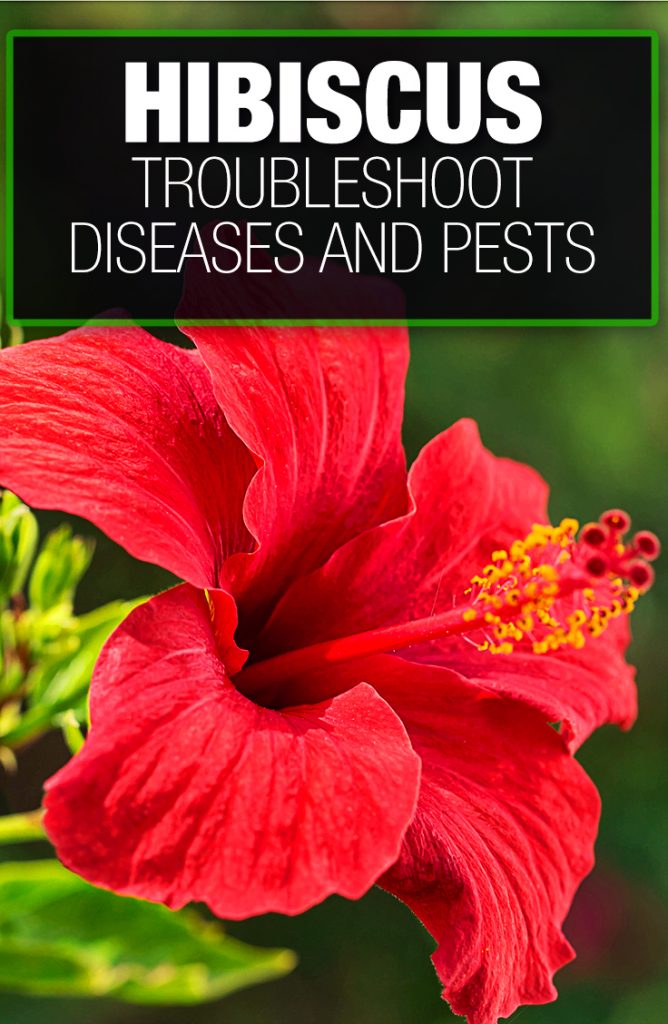
Keep Your Plants Healthy
Many pest and disease problems can be prevented by using good cultural practices.
- Plant your hibiscus in a sunny location. In very hot climates, a little afternoon shade is appreciated.
- Be sure to plant in an area with good soil drainage. They like a moist but well-draining soil.
- Water properly. They need to be constantly moist but not waterlogged. Never let your plant dry out entirely or sit in water.
- Hibiscus are heavy feeders. Use a balanced fertilizer (such as a 14-14-14 fertilizer) weekly.
The Disease Triangle
For a plant disease to take hold, there needs to be three things:
- A susceptible host (your plant)
- The pathogen (the disease)
- The conditions that favor the disease, including time for the disease to establish
The side of the triangle that gardeners have the most control over is environmental conditions. Good cultural and sanitation practices will help prevent a lot of diseases by keeping plants healthy. A healthy plant is better able to fend off infections – and insect infestations, too
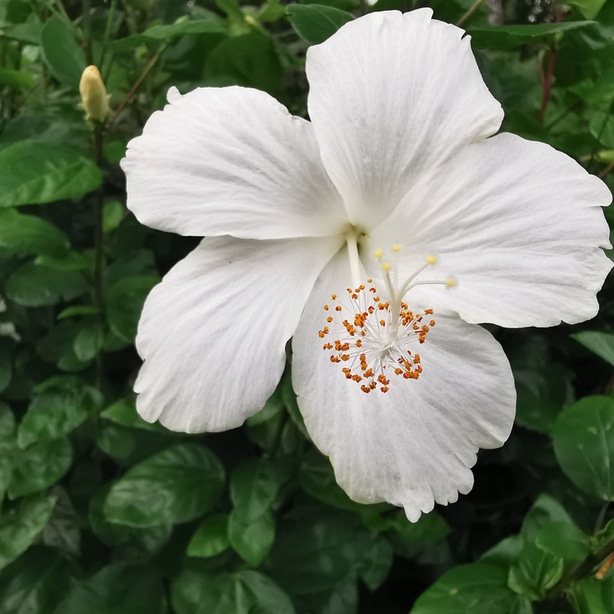
Common Diseases
Hibiscus are sometimes troubled by:
- Leaf spots, caused by fungi and bacteria
- Wilts and rots, caused by soil fungi and bacteria; and by improper cultural practices
- Dieback, caused by fungi and bacteria
- Molds and mildews, caused by fungi
Diseases that Cause Spots on Leaves
Spots on leaves can be caused by bacterial or fungal diseases, and by scale insects.
Black Spot
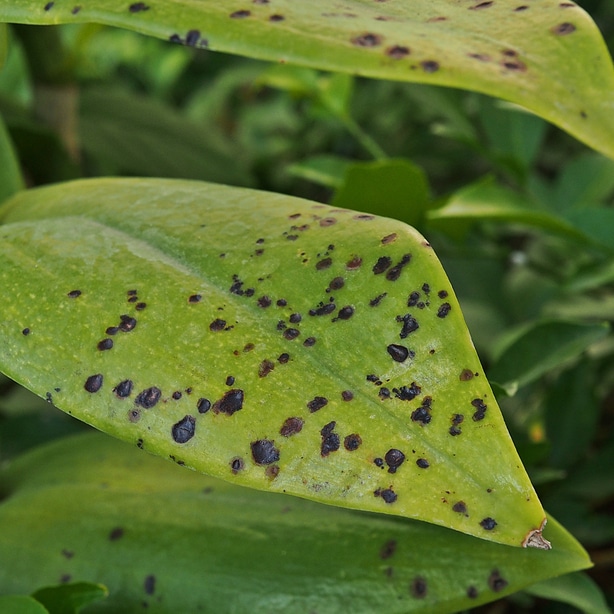
Black spots that appear on the upper surface of leaves can be bacterial or fungal Fungal leaf spots, known as black spot, are unattractive, but do not harm the plant. The fungus grows in cool, damp weather.
Fertilizer can help your hibiscus grow fresh new leaves, but no cure can make black spots go away. Cleaning up fallen infested leaves can help keep the disease from spreading. Badly infested leaves can be removed from the plant and destroyed.
Bacterial Leaf Spot (Pseudomonas cichorii)
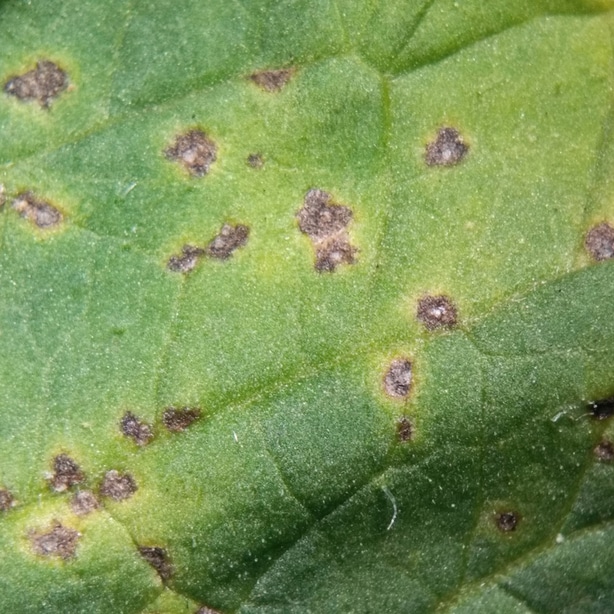
Bacterial leaf spot – Pseudomonas cichorii – develops in wet and rainy weather and is spread by splashing water. Pseudomonas cichorii spots have rings of different colors on the outer edges. If severe, leaves may fall off, but this disease doesn't cause severe damage.
As with black spot, good sanitation is important with bacterial leaf spot. Removing leaf debris from under the plant, pruning out badly infested branches, and watering from below will help keep this disease in check.
Small Black or Brown spots
Small black or brown spots on the underside of leaves or stems could be scale insects. We discuss scale in the pest section of this article.
Yellow Leaves
To figure out why hibiscus leaves are yellowing, you need to be a bit of a detective. Yellowing leaves can be caused by too much or too little water, too much or too little sunlight, too hot or too cold temperatures, spider mites, or poor nutrition. It can also be a natural part of the aging process as the leaves turn yellow and fall off to make way for fresh new leaves.
When tropical hibiscus are brought indoors for the winter, the change in light levels can cause leaves to turn yellow and drop. This also happens when it is going dormant.
Examine your plant closely, consider the environmental factors, and the care you've given your plant. Then look for insects (more on that below) that could be causing the problem.
Rust
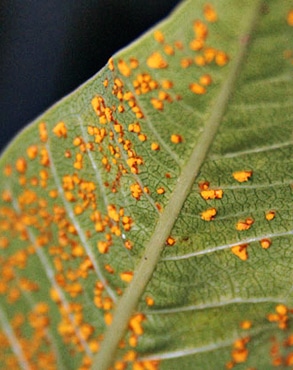
Hollyhock rust is a fungal disease that can develop on hibiscus and is identified by yellow or orange raised dots (pustules) on the leaves' underside and rusty colored spots on the tops. When you touch it, it can leave rusty marks on your fingertips. It develops when the foliage has been too wet for too long.
It can kill the foliage, and other plant parts can also become infected. Over time, rust can cause plans to decline and even die.
Good sanitation is important. Rake up all fallen leaves, and prune out and destroy badly infected branches. Improve air circulation, and don't water from overhead. At the start of the growing season, previously afflicted plants can be sprayed with horticultural oil before the foliage emerges. This works to prevent new diseases.
Wilts and Rots
Hibiscus plants wilt for different reasons. Some wilts are caused by pathogens in the soil, and others are caused by water stress or cold shock
Wilt Disease
Wilt diseases are caused by pathogens in the soil. Fusarium and verticillium are common and attack other plants as well, not just hibiscuses. These diseases enter the plant through the roots and prevent the plant from moving nutrients and water through its system. Hibiscus plants wilt and die back suddenly, even if the soil is moist . Leaves are shriveled, but not yellow. This disease is sometimes called root rot, but that is a separate condition (more on that below).
Dieback Disease
When one branch wilts and the rest of the plant is healthy, it is most likely dieback disease. This is caused by a fungus or bacteria entering a stem through a wound. The best cure is to prune out the wilted branch. Follow it back until you find the wound. Then, using clean clippers, cut the branch a few nodes below the wound. The cut end should be white with no streaks. If there are streaks, cut back a little further until you see clear wood.
Root Rot
Root rot is caused by water stress and occurs when the soil is too wet for too long. If you grow hibiscus in well-draining soil, you are well on your way to preventing root rot. If you are growing in a container, you will need a lightweight potting medium.
If your plant has root rot, leaves will turn yellow and fall off. Roots will be mushy and brown. On the other hand, healthy roots are firm and white.
Be sure that water drains away from the soil that your plant is situated in and that potted plants do not have standing water in the saucers. Keep your watering schedule consistent so that the soil is always moist but not soggy. Don't let hibiscus dry out (a dried-out hibiscus will also wilt) and then flood it water – this can also cause root rot.
Molds and Mildews
Botrytis Blight
This fungal disease is also known as gray mold, forms on buds, flowers, and foliage. High humidity and reduced air flow create the environment for botrytis to develop. Flowers are discolored and spotted, flower buds rot and fall off before opening.
Prune out all infected flowers and foliage and destroy it. Don't compost it, as botrytis can live in the compost. Don't water from overhead; try to keep the foliage dry. If botrytis is a continuing problem, a fungicide can be used as a preventative.
Powdery Mildew
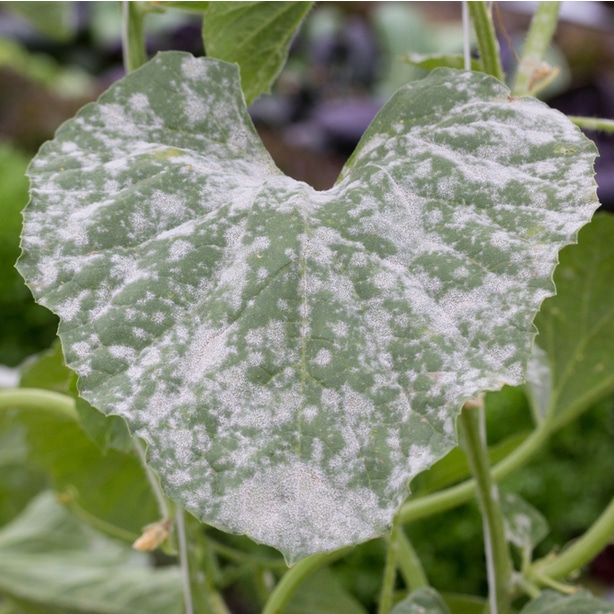
Powdery Mildew is a fungal disease that manifests as a white coating on the foliage and stems. This develops when days are warm and nights are cool in late summer and early autumn. Most of the time, powdery mildew does not harm the plant; it's just unsightly.
To control powdery mildew, fungicide need to be applied before the plant shows symptoms. As with other fungal diseases, watering the soil and not the foliage helps reduce the moist conditions that powdery mildew likes.
Don't confuse powdery mildew with mealybugs. Powdery mildew is a white velvety coating on the leaves; mealybugs are a white cottony mass nestled into buds, leaf axils, and on stems (more on mealybugs later in this article).
How to Treat Fungus on Hibiscus
Short answer: You don't. You can't.
Fungicides work to prevent a fungus, they don't cure it. Once a fungal disease takes hold, no treatment can make it go away. Here's what you can do:
- Chose resistant varieties. Plant breeders are continually working to develop plants that can resist diseases. Do your homework before you buy.
- Avoid conditions that favor the fungus. Keep foliage dry, don't plant too closely, and prune to encourage good air circulation.
- Keep your plants healthy so they can better fend off any fungal disease. Weak plants succumb more easily.
- Practice good garden hygiene. Water spreads diseases, so clean up any plant debris under your hibiscus to keep rain from splashing fungal spores back up into the plant. And keep your garden tools clean, too.
- If you chose to use a fungicide, follow the label directions carefully and be sure you are applying it at the right time.
Pests
Keeping a good eye on your hibiscus – scouting – can help you spot insect problems before they become severe and damage your plant. Insect pests on hibiscus can be controlled with insecticidal soap, or a hard spray from the garden hose can dislodge them. Be conscientious if you decide to use a chemical pesticide. While you might kill the pest, you could also kill the predatory insects that would do the job for you or kill beneficial insects like honey bees.
Here's what "bugs" hibiscus and the symptoms to look for.
Spider mites
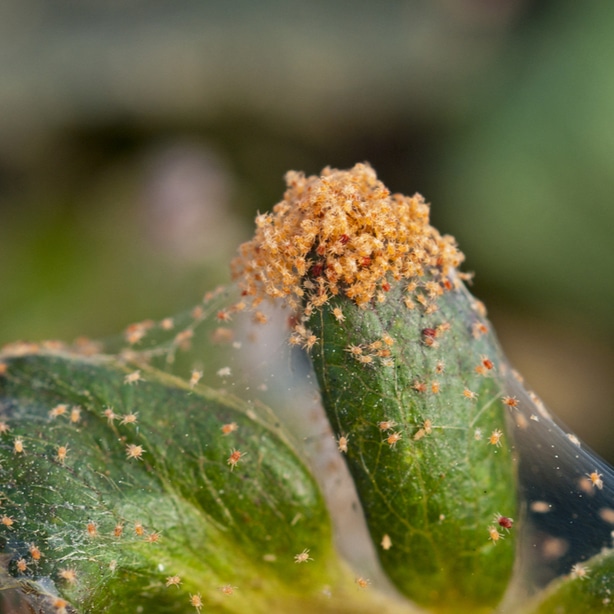
Spider mites are not insects, they are arachnids with 2 body parts and 8 legs. They are very, very tiny and almost impossible to see with the naked eye, so look for fine webbing in branch crotches and leaf axils. Use a magnifying glass to find them or shake a branch of your hibiscus over a sheet of white paper and watch for tiny moving dots.
Spider mites suck juices out of the leaves, creating a mottled appearance. In heavy infestations, foliage withers and dies. Rarely do they kill the plant.
Spider mites can be removed with a strong blast of water from your garden hose. If you chose to use a pesticide, be sure to use a miticide, not an insecticide
Aphids
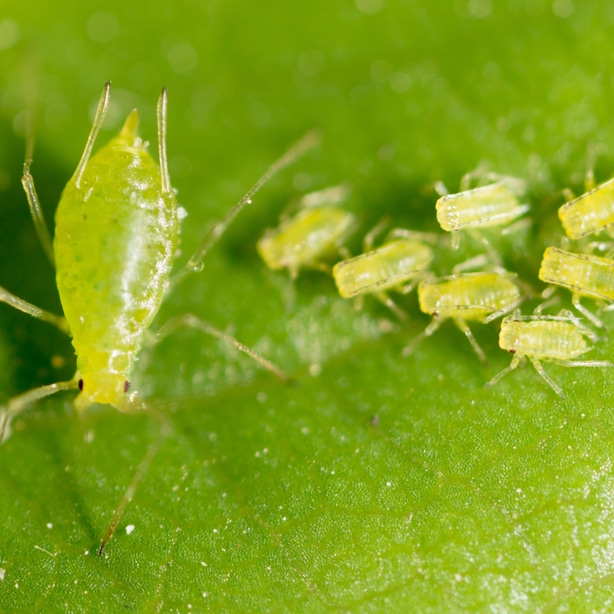
Aphids are small, soft-bodied insects that suck juices from plant parts, creating a mottled appearance on the leaves. They live in a colony and often can be observed in rows up and down hibiscus stems and on the flower buds. Different species are different colors – they may be green, white, black, or red. They secrete a sticky honeydew that is very attractive to ants. If you see a lot of ants on your hibiscus, it could be an indication of aphids. The honeydew can also cause sooty mold to grow.
If left unchecked, aphid colonies can explode and cause significant damage. Leaves will be distorted, yellowed, and curled.
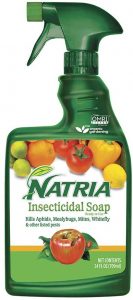
Control aphids with insecticidal soap or a systemic insecticide. You can also squash them with your gloved fingers or wash them away with a blast of water from the garden hose. Ladybugs and lacewings eat aphids – you can even purchase these beneficial insects by mail and release them into your garden.
Scale
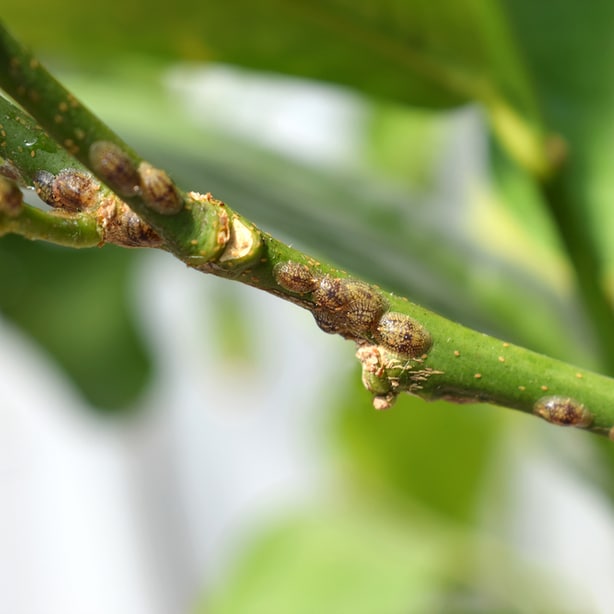
Scale on hibiscus – and other plants too – look like small black or brown raised dots. They do not move – adult female scale stay in one place their entire life. Their children – females all – are on the move shortly after hatching until they find a place to settle, grow a protective cover, and start laying eggs. Scale are another insect that suck the juices out of plants and large infestations can cause severe damage.

Because of their armored shell, which insecticidal sprays cannot penetrate, scale should be controlled with systemic insecticides. Small infestations can be scraped off with your fingernail.
Whitefly
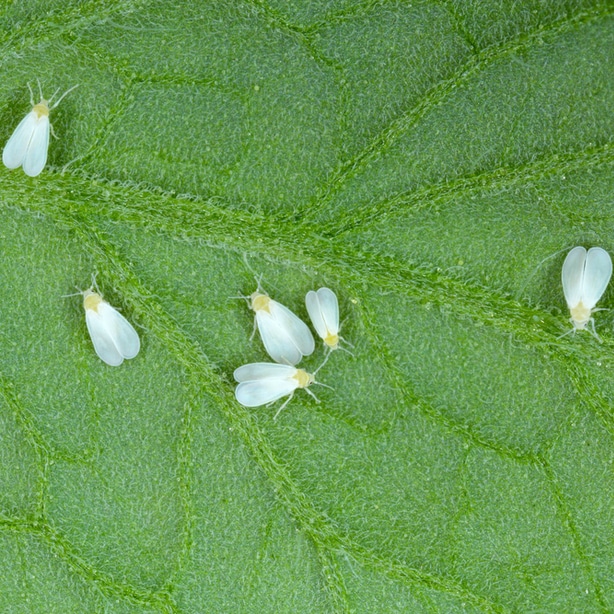
Whiteflies are bright white, gnat sized insects that feed on plant juices, usually from the underside of the leaves If you suspect whiteflies, a good shake of a branch will bring up a cloud of them. They only survive the winter outdoors in zones 7 and above.
Whiteflies cause foliage to turn yellow, shrivel, and drop off. They also produce honeydew, which can cause sooty mold.
Whitefly adults cannot be sprayed, they just fly away. Horticultural oil can be applied to smother the eggs and nymphs (the juvenile stage). Or use a systemic insecticide that is applied to the soil.
In colder areas, whiteflies are a problem in greenhouses, but can occur when you bring your tropical hibiscus indoors for the winter. Indoors, control whiteflies with yellow sticky traps. Sticky traps would be effective in small infestations outdoors as well.
Mealybugs
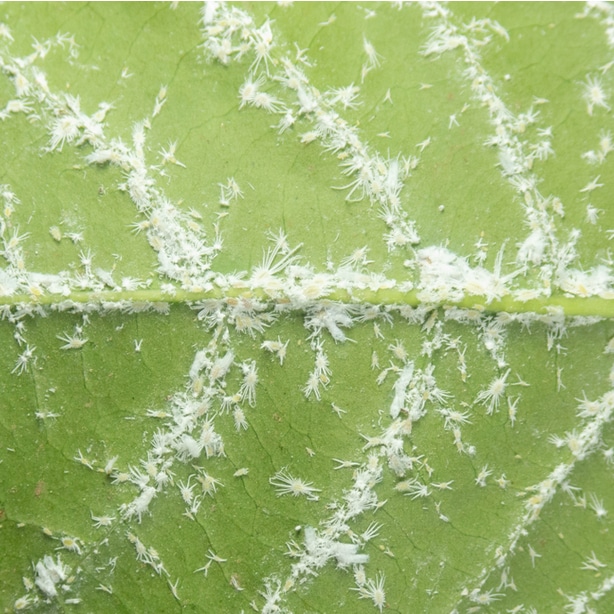
Mealybugs are white, soft-bodied insects sometimes within a cottony mass. They feed on plant juices, which can cause stunted growth and prevent flowers from opening. Mealybugs produce honeydew on which sooty mold can develop. They are usually in crotches of branches and stems and at leaf and bud axils.
Mealybugs are tropical and can appear on your Hibiscus rosa-sinensis after you bring it indoors for the winter. Small infestations can be managed by dabbing a cotton swab dipped in rubbing alcohol on them. Insecticidal soap can be used, or a systemic insecticide. Or consider the predatory insect cryptolaemus, the mealybug destroyer.
Thrips
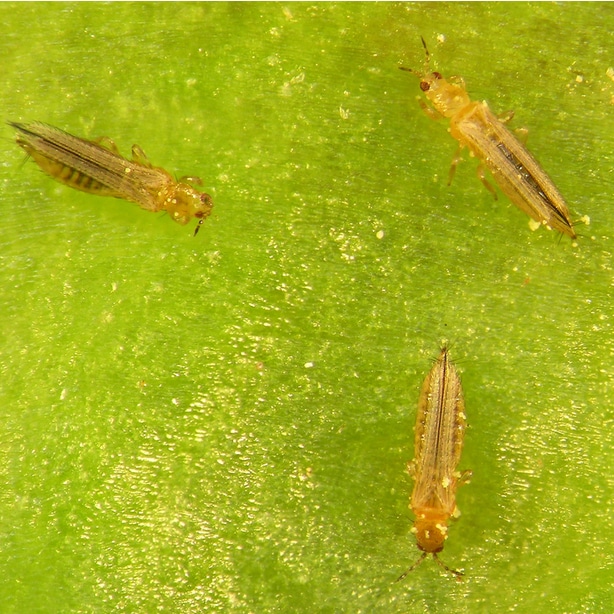
Thrips are very tiny insects with a very narrow body. Adults lay eggs in flower buds and the larvae feed on the bud. This causes the buds to change color and drop off before flowering. The larva then pupate in the soil, emerging as adults to being the cycle again. Because thrips are so hard to see, bud drop is the number one indicator that your plant has thrips. Thrips also leave marks that look like scratches on leaves and flowers.
Control thrips by removing all infected flower buds and raking up the fallen ones. A systemic insecticide will work better than a spray. A spray cannot reach inside the bud to where the thrips live.
How to Get Rid of Black Bugs on Hibiscus
Source: https://www.thegreenpinky.com/hibiscus-diseases-and-pests/